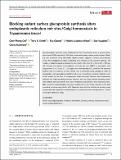Blocking variant surface glycoprotein synthesis alters endoplasmic reticulum exit sites/Golgi homeostasis in Trypanosoma brucei
Abstract
The predominant secretory cargo of bloodstream form Trypanosoma brucei is Variant Surface Glycoprotein (VSG), comprising ~10% total protein and forming a dense protective layer. Blocking VSG translation using Morpholino oligonucleotides triggered a precise pre-cytokinesis arrest. We investigated the effect of blocking VSG synthesis on the secretory pathway. The number of Golgi decreased, particularly in post-mitotic cells, from 3.5 ± 0.6 to 2.0 ± 0.04 per cell. Similarly, the number of ER exit sites (ERES) in post-mitotic cells dropped from (3.9 ± 0.6) to (2.7 ± 0.1) eight hours after blocking VSG synthesis. The secretory pathway was still functional in these stalled cells, as monitored using Cathepsin L. Rates of phospholipid and GPI-anchor biosynthesis were relatively unaffected, except for the level of sphingomyelin which increased. However, both ER and Golgi morphology became distorted, with the Golgi cisternae becoming significantly dilated, particularly at the trans-face. Membrane accumulation in these structures is possibly caused by reduced budding of nascent vesicles due to the drastic reduction in the total amount of secretory cargo, i.e. VSG. These data argue that the total flux of secretory cargo impacts upon the biogenesis and maintenance of secretory structures and organelles in T. brucei including the ERES and Golgi.
Citation
Ooi , C-P , Smith , T K , Gluenz , E , Wand , N V , Vaughan , S & Rudenko , G 2018 , ' Blocking variant surface glycoprotein synthesis alters endoplasmic reticulum exit sites/Golgi homeostasis in Trypanosoma brucei ' , Traffic , vol. Early View . https://doi.org/10.1111/tra.12561
Publication
Traffic
Status
Peer reviewed
ISSN
1600-0854Type
Journal article
Description
This work was supported in part by a Wellcome Trust Senior Research Fellowship award (067441) to T.K.S. G.R. is a Wellcome Senior Fellow in the Basic Biomedical Sciences (095161). This research was funded by the Wellcome Trust.Collections
Items in the St Andrews Research Repository are protected by copyright, with all rights reserved, unless otherwise indicated.

